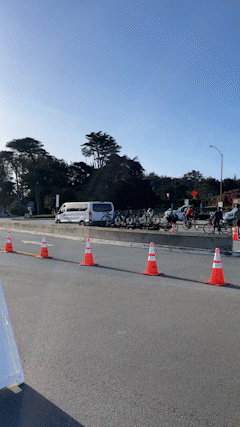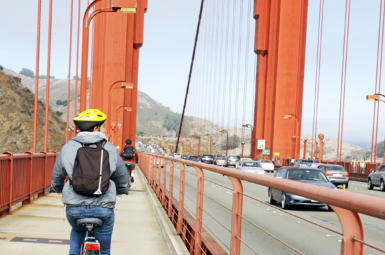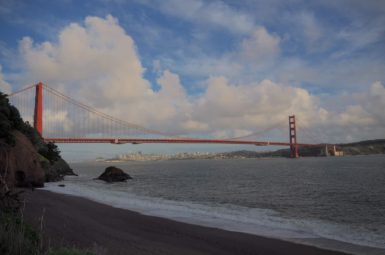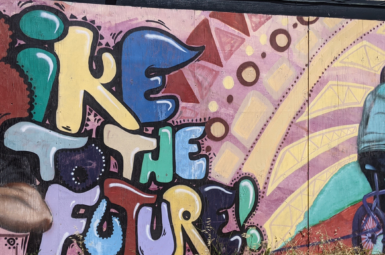Golden Gate Bridge Barely-Announced Bridge Closure Leads to Massive Backup
On Sunday, November 7th, the Golden Gate Bridge hosted its annual half marathon. It was a beautiful brisk morning, the perfect day for a run (or a bike ride). While the marathon was kicking off, hundreds of cyclists, both commuters and recreational riders, headed to the Golden Gate Bridge to travel between San Francisco and Marin, as many do every Sunday.
Riding the Golden Gate Bridge is never easy on the best of days, but it’s the only link that riders have, and beggars can’t be choosers. Unfortunately, what riders found when they arrived was far worse than what they have come to expect.
Unbeknownst to many riders, the half marathon entailed a full closure of both the east and west sidewalks to bicycles, beginning at 6:30 AM and ending at 10:30 AM. Rather than widely publicize the closure, notice for the event seems to have been limited to a small amount of signage on bridge approaches installed the week before the event, and a link on the GGBHTD “events” page, which few think to check before a ride. This led to massive lines of riders at the bridge, and untold dozens (perhaps hundreds) of people simply turning around and going home. Some of those fortunate enough to have cars went home, put their bike on a rack, and drove across the bridge instead.
We’ve heard from a number of people who were affected by this barely-announced closure. Below is a catalog of what went wrong, stories from some of the people who were affected, and recommendations for bridge staff and leadership going forward.
What Went Wrong
Publicity
From what we can tell, the Bridge District did the absolute minimum of publicity around the closure, limited to (1) posting a small sandwich board sign on the approaches to the sidewalk and (2) posting the event to their website.
What they did not do was notify either MCBC or the San Francisco Bicycle Coalition, nor did they post anything on their social media page, nor did they use their various email subscription services to notify those who have signed up for them.
Shuttles
At times when there is a planned closure for bicycles on the bridge, the Bridge District employs a two-vehicle shuttle service. While this is better than nothing, it is highly limited in its usefulness.
To start with, despite having capacity for eight riders and their bikes, drivers on November 7th were under instruction to limit capacity to four passengers for Covid reasons despite the fact that the transit agency run by the Bridge District, Golden Gate Transit, had removed Covid-based capacity limitations back in July. We also heard that some riders had left home without masks, not expecting to have to ride transit.
Capacity Constraints
Even with the two shuttles running at full capacity, they can only transport a fraction of the people who ride across the bridge on a typical nice fall morning. Two shuttles making the 3-mile round trip can transport a maximum of ~100 riders per hour. The most recent counts collected by the Bridge District show that 2.5x that number of people ride the Bridge every hour on an average Sunday morning. So at most, only 40% of the riders trying to cross the Bridge can be accommodated.
Testimonials
Below are several of the personal stories we received. We heard from over a dozen people in total.
I attempted to cross the bridge around 8:30 AM only to be met with security at the bridge and a long line to use the shuttle (maybe 30-40 cyclists). I waited a few minutes, but it appeared like the line wasn’t moving, so I just left. Most riders decided to leave as well.
I didn’t receive any prior notice that the bridge would be shut down. I try to keep up to date on all that stuff. I have a newborn and very limited time to ride these days, so it’s frustrating to have to cancel a ride. I would’ve made alternative plans if I knew the bridge was shut down.
-Kelly K.
—
Last Sunday I loaded up the car in Marin for a bike adventure to the city with my wife and 2 kids (2 and 5). The plan was for my wife to ride her bike and have me tow both kids in the double stroller. Our plan was to park in Sausalito, ride to the SF Zoo and spend the morning there, and ride back for a late lunch in Sausalito.
We parked in Sausalito, loaded our bikes and hooked up the trailer, and set off for the bridge. When we arrived, the bridge was closed to cyclists. There was a small van with a large line of riders and no ability to transport our double stroller across the bridge. We were forced to turn around and head back to the car. I ended up driving the kids to the zoo instead, and we no longer had time for lunch in Sausalito at the tail end. Such a bummer! I wish I had gotten notice that the bridge was closed for the morning.
-Phil M.
—
Both my partner and I were impacted by the unknown bridge closure. We got there around 8:45 and the line was massive. People said they’d been waiting for 45 mins and they were only taking 4 at a time / some people didn’t bring masks because they didn’t know so we biked the 7 miles home to go get our car and drive across.
Also, when we got the bridge I asked if it was closed and a worker told me to “read the sign.” There was one sign that said there was a “Sporting event” on Sunday morning but didn’t say anything about the bridge being closed or times. I said that it would have been cool if we had known and he said “it’s online.” When I asked where he just walked away. We would have slept in and rode on the trainers. We would have done a lot of things differently.
-Maddie H.
—
My experience was basically that I had plans to meet people in Sausalito at 9 AM for a ride and found I unexpectedly couldn’t cross the bridge. I’m usually fairly aware of closures from various sources so I was surprised to find this was the situation. I don’t have a car right now so bike or walk was the only option. They wouldn’t even allow us to walk across the bridge with the bike.
I waited in line for about 35 minutes – I was pretty lucky, the line got significantly longer after I was in it. The shuttle was quick after that, but they were only taking 4 bikes at a time despite having 8 racks on each shuttle. This was pretty confusing because they did let more pedestrians on board the shuttles with the cyclists if they didn’t have bikes
I hadn’t heard anything about the closure. A sign by the bridge isn’t enough, especially with less daylight (and therefore less weekday trips over the bridge).
-Chase T.
—
A dear friend was in town the whole week and we rode the city exhaustively, planning Marin for Sunday. [Because of the closure] my friend, an exceptional lifelong cyclist, didn’t get to ride Marin.
We are both car-free, and had no options by the time we discovered Marin was inaccessible to us. We could have planned to ride from Richmond BART, had we been alerted, but it was too late to loop around by the time we discovered
The whole thing shows me that they think of cyclists as hobbyists. I’m disabled and can’t drive. Other people commute across that bridge, but they don’t bother to notify us because we aren’t as important as drivers
-Philip D.
What Has Happened Since
To the credit of the Bridge District, they have expressed their regret at the way the November 7th closure was handled. General Manager Denis Mulligan conveyed his apology to the bicycle community at the November 19th meeting of the Board of Directors after our comment on the incident.
A run that took place the following weekend, which entailed yet another closure of the sidewalk, was posted to Bridge District social media and subscribers to email notifications received a notice.
Additionally, thanks to our questions, the outdated Covid-based capacity limitations on the shuttles have been repealed, doubling the capacity. While this is at best an interim step, it represents an improvement on the chaos of November 7th.
What Can Be Done
The Golden Gate Bridge is not only an icon of the American imagination, it is a key piece of transportation infrastructure. Why then are recreational events, such as marathons or other runs, cutting off (or at best, severely limiting) the ability of people to ride a bike across the bridge?
As Bridge District Board Member Michael Theriault has noted, marathons used to run on the bridge deck before the terrorist attacks in Nice, France in 2016, in which attackers drove a truck into a crowd of people. Rather than risk something like that occurring here, bridge leadership in 2017 closed the bridge to northbound auto traffic. However, they later decided that such a closure was at odds with the bridge’s role in the transportation network, and in subsequent years simply shifted runners to the sidewalk to maintain automobile access.
This choice, as we saw on November 7th, shifts the burden on the bicycle riders. Time after time, travel by bicycle is cast by our leaders as unserious and “recreational” in nature. But we never limit car traffic to only those traveling to work – no doubt many drivers crossing the bridge were on their way to a trailhead in Marin.
In a time where we know we need to be limiting GHG emissions, actively discouraging riding bikes, whether for strict transportation or recreation while doing everything to maintain automobile access is wildly counterproductive.
MCBC urges the Bridge District to return to a policy of maintaining bicycle access rather than cutting it off for hours on multiple consecutive weekends. This could entail placing temporary barriers on the bridge, or protecting runners with the moveable barrier and temporarily lowering the speed limit for the two-way vehicle traffic.
We trust in the creativity of bridge staff and leadership. We believe that, if they want to, they can find a way to maintain access to the bridge for people traveling by bicycle during running events. And in a time of climate crisis, we believe that this would be a golden opportunity to signal commitment to a sustainable, low-carbon future.
sign-up for advocacy alerts
We will need your help winning these improvements! Please sign-up for advocacy alerts using the form below and we’ll tell you when/how to support our efforts.
members make it happen
We’re working to make Marin more bike-friendly for people of all ages and abilities. Are you with us?
